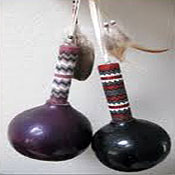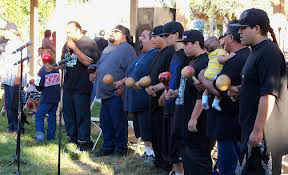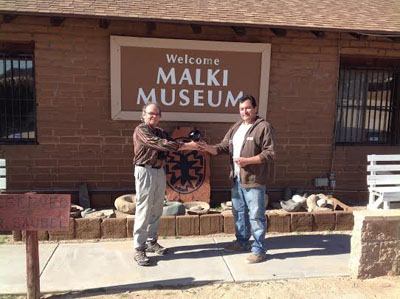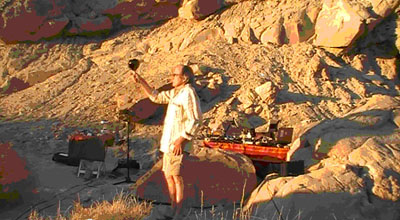



After my pilgrimage to Chaco Canyon, New Mexico in 2012 for the winter solstice I discovered how the geographical landscape contributed to the quality of sound made by musical instruments. It was from that experience that I searched for another geographical location which might provide additional insight into how the geological surroundings would be a possible acoustical site to once again produce sounds. It wasn’t long after returning from Chaco Canyon that I decided to locate an area that had an unobstructed view of the night sky as well as a geographical area removed from the urban landscape. My research uncovered the darkest night sky in North America in the wilderness area known as the Anza Borrego Desert in Southern California. I knew absolutely nothing of this area but was drawn to the area known as the Wind Caves. By chance I discovered the book, The Forgotten Artist: Indians of Anza-Borrego and Their Rock Art, written by Manfred Knaak; professor emeritus Imperial College in Southern California. It was Dr. Knaak who suggested I visit the Malki Museum, founded by the late Elizabeth Siva Saubel. It was only then that I learned of the Cahuilla people and their creation myths which are still represented today by the ancient Bird Song chants. The Bird Songs are sung with a very special rattle made by the Cahuilla people and I wrote to Richard Rodrigue, Museum Director of the Malki Museum, inquiring as to whether I could have a rattle made for me by one of the members of the Cahuilla tribe. I was told it would be possible and to my surprise when I flew from Bangkok, Thailand to California and then drove to the Malki Museum in Banning, California from San Francisco I was presented a rattle made by Arron Saubel; the grandson of Elizabeth Siva Saubel.

I was also fortunate to have recorded several Bird Songs sung by Arron Saubel and have added them here to listen to.

I could not help but think of all the petroglyphs Manfred Knaak put into his book and could understand more directly why this land was such a sacred land to the Cahuilla people and was used by Cahuilla shamans for hundreds of years before the Cahuilla people were slowly assimilated into the ways of the occupiers of the land. The Bird Songs are still sung by the Cahuilla people today at annual events. However, experiencing firsthand the songs of the real birds that live in the canyons of Anza Borrego gave me a much deeper insight into the sacredness of this land. Link to photo essay at Anza Borrego:
I requested that my rattle be painted black to reflect the night sky. When I was presented the rattle I could feel the energy it possessed. It was made perfectly and inside was the palm seeds native to the trees in that area. The sound the rattle makes is difficult to describe but it has an electric like sound with repetitive beats. The size of the gourd also enables the seeds to be rolled around inside giving off a continuous white noise effect as if it were raining. When I used the rattle in the Mud Hill Wash you could hear the sound of the rattle reverberate all over the canyon. It was an experience I will never forget, and it brought me in touch with a very ancient way of life that was made more authentic as it was enhanced by a direct manifestation of a rattle made by a member of the Saubel family as well as the work of Elizabeth Siva Saubel who had over her 91 years made sure that the Cahuilla people would never be forgotten with the founding of the Malki Museum. What was originally intended as a journey to make sounds under a clear night sky during the winter solstice, ended up as a communication with the ancient spirits of the land once occupied by the Cahuilla people. And if as I had originally intended to communicate with extraterrestrials, I feel that the spirits of the Cahuilla people talked to me directly and brought me to the realization that those spirits are as real as any extraterrestrial.
The type of sounds made at these indigenous locations I refer to as Astro Ethnic Music and my next planned location is to visit the sacred valley of Peru in Dec of 2014. If anyone is interested to learning more of this pilgrimage you can contact me at vanflight@gmail.com.
Return to: South East Asian Review |